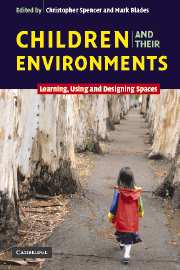Book contents
- Frontmatter
- Contents
- Notes on contributors
- An introduction
- Part I Children's understanding of places
- Part II Children's experience of places
- Part III Adolescents' worlds?
- 10 On the other side of the tracks: the psychogeographies and everyday lives of rural teenagers in the UK
- 11 The socio-environmental affordances of adolescents' environments
- Part IV Children and the design process
- Index
- References
10 - On the other side of the tracks: the psychogeographies and everyday lives of rural teenagers in the UK
Published online by Cambridge University Press: 23 October 2009
- Frontmatter
- Contents
- Notes on contributors
- An introduction
- Part I Children's understanding of places
- Part II Children's experience of places
- Part III Adolescents' worlds?
- 10 On the other side of the tracks: the psychogeographies and everyday lives of rural teenagers in the UK
- 11 The socio-environmental affordances of adolescents' environments
- Part IV Children and the design process
- Index
- References
Summary
Introduction
The notion of a rural idyll stubbornly persists as a common conception of the British countryside – especially so, when family life and young people are thought about. For many onlookers, rural places are conceived as safe, risk-free, community-rich spaces where parents can bring up their children in trouble-free ways, away from the turmoil and social tumours that comprise the canker of urban living today. A much-repeated mantra amongst those moving from towns to take up residency in rural villages is that these are better, socially healthier places in which to grow up (Valentine, 1997a). Jones (1997, 2000) suggests that the evocation of a bucolic Arcadia is engrained within the cultural fabric of British (especially English) society. He draws attention to a substantial body of literature, whose re-reading by successive generations portrays the countryside as a haven of ‘primitive innocence’, the last refuge of a state of humanity defined by a ‘wholesome naturalness’ that enables children to develop in pure, unblemished, almost perfect ways (Matthews et al., 2000a: 141). By setting apart the ‘authenticity’ of Nature from the artifice of the town, the countryside becomes a place of the sublime and thus of enriching spirituality; bleak, possibly, but always awesome and humanizing. These values have become degraded over time into a hand-me-down romantic attitude (lower case ‘r’). The observations of Shoard (1980) typify this view.
- Type
- Chapter
- Information
- Children and their EnvironmentsLearning, Using and Designing Spaces, pp. 161 - 175Publisher: Cambridge University PressPrint publication year: 2006
References
- 10
- Cited by

